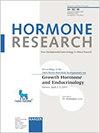Familial tumoral calcinosis caused by a novel FGF23 mutation: response to induction of tubular renal acidosis with acetazolamide and the non-calcium phosphate binder sevelamer.
引用次数: 46
Abstract
Hyperphosphatemic familial tumoral calcinosis (HFTC) is an uncommon disease characterized by periarticular calcifications produced by the deposition of amorphous extraosseous calcifications of hydroxyapatite. It is associated with hyperphosphatemia due to increased tubular phosphate reabsorption, despite normal renal function and normal plasma PTH levels. The disease can be caused by inactivating mutations in either the fibroblast growth factor 23 (FGF23) gene, the UDP-N-acetyl-D-galactosamine:polypeptide N-acetylgalactosaminyltransferase 3 (GALNT3) gene or in human KLOTHO (KL) gene. Herein, we describe a Caucasian 3-year-old girl with tumoral calcinosis who presented with elevated serum phosphorus levels and a large calcified mass at her left elbow which led to ulceration of the skin. Treatment with the phosphate binder sevelamer and the carbonic anhydrase inhibitor acetazolamide successfully reduced the serum phosphate levels and led to a reduction of the calcified mass. This medical management has not been described previously. Her 7-month-old sister also had elevated serum phosphate levels, but did not have ectopic calcifications. Sequencing analysis revealed a novel homozygous FGF23 missense mutation (c.367G>T, p.Gly123Trp) in both siblings while the parents were carriers of the mutation.由一种新的FGF23突变引起的家族性肿瘤钙血症:对乙酰唑胺和非磷酸钙结合剂诱导肾小管酸中毒的反应
高磷血性家族性肿瘤钙化症(HFTC)是一种罕见的疾病,其特征是由羟基磷灰石的无定形骨外钙化沉积产生的关节周围钙化。尽管肾功能和血浆甲状旁腺激素水平正常,但由于管状磷酸盐再吸收增加,它与高磷血症相关。该疾病可由成纤维细胞生长因子23 (FGF23)基因、udp - n -乙酰- d -半乳糖胺:多肽n -乙酰- d -半乳糖胺转移酶3 (GALNT3)基因或人KLOTHO (KL)基因失活突变引起。在此,我们描述了一个3岁的白人女孩肿瘤钙化症,她表现为血清磷水平升高,左肘有一个大的钙化肿块,导致皮肤溃疡。用磷酸盐结合剂sevelamer和碳酸酐酶抑制剂acetazolamide成功地降低了血清磷酸盐水平,导致钙化肿块的减少。这种医疗管理以前没有描述过。她7个月大的妹妹也有血清磷酸盐水平升高,但没有异位钙化。测序分析显示,两兄妹均存在一个新的纯合子FGF23错义突变(c.367G>T, p.Gly123Trp),而父母是该突变的携带者。
本文章由计算机程序翻译,如有差异,请以英文原文为准。
求助全文
约1分钟内获得全文
求助全文

 求助内容:
求助内容: 应助结果提醒方式:
应助结果提醒方式:


